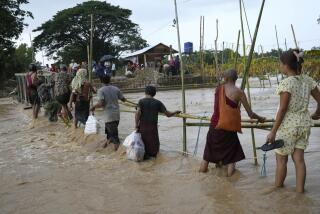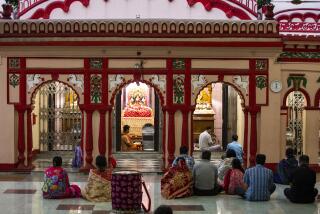Bangladesh Isle Bears Brunt of Nature’s Curse : Disaster: National toll hits 125,000. Vast stretches of farmland are ruined by wave that swept 25 miles inland.
- Share via
RAHAMATPUR, Bangladesh — Rahamatpur means “blessing of God” in Arabic, but for Minul Islam Belal and his neighbors, this impoverished hamlet now seems cursed from hell. Belal’s entire extended family--35 people in all--was washed out to sea or crushed under falling buildings when Tuesday’s catastrophic cyclone smashed ashore here with unimaginable force.
“Why do I live and they all die?” Belal, a 28-year-old farmer, asked Saturday. “What do I have to live for? This is my question. This is my tragedy.”
The tragedy is far worse. The government now says at least 125,000 people were killed in the savage storm and fierce tidal wave that rushed up to 25 miles inland. Unofficial estimates are as high as 300,000 dead on the crowded southeast coastal delta and nearby islands.
Here on Sandwip Island, which bore the brunt of the storm’s fury as it roared across the Bay of Bengal, a strange calm pervades a muddy, water-soaked land of death and destruction. Local officials say at least 25,000 people are dead or missing. Four out of five homes--mostly mud-and-thatch huts--are flattened, with most other buildings badly damaged. Fertile fields are flooded with saltwater; thousands of cattle are dead. Most food stocks, water wells, communications and even drugs in the simple hospital were destroyed.
“Already there is cholera,” said Dr. Shishir Ranjan Das. “My hospital is already full with cholera. And so many people are suffering diarrhea. But no medicine. Just mental prescriptions--suggestions and advice.”
Despite mass graves dug in the mud, bloated bodies still litter the flooded fields. On one stream, a fisherman cast his net and a woman filled a tin pot with muddy water 20 yards from where a woman and two children lay sprawled on the bank, their naked corpses yellow and black in the steamy tropical heat. Nearby, Abdul Hanan, 50 and nearly toothless, simply grabbed a visitor’s arm and pleaded softly for help. He had lost 10 family members, including seven children, in the swirling seas.
“I cannot even cry,” he said. “I cannot.”
A seven-mile hike through three villages showed most huts were turned to matchsticks, with twisted tin roofing creaking in the wind. Thousands of homeless are crammed into a three-story concrete college building, cooking food in the classrooms.
Others used long bamboo poles to pull scores of decomposing cattle carcasses from the fields. A salty breeze carried the stench of death.
Two hundred tons of rice stored in a local government warehouse has been distributed. But 500 tons was destroyed, and relief operations have barely begun here or anywhere else.
The military has only two helicopters and two small cargo planes to ferry supplies to more than 5 million people believed homeless in the 100-mile stretch of coastline from Feni to Chittagong and down to Cox’s Bazar, said Maj. Gen. Mahmudul Hasan, head of the Chittagong military garrison. And barely half the area has been surveyed so far.
“I am feeling so guilty, I don’t feel like showing my face to people,” Hasan said, using a bamboo swagger stick to point on a giant map in his office. “The magnitude of disaster is so bad, and we have so little.”
He said large-scale distribution of food and water is impossible in vast areas where floodwaters cover the land and countless raging rivers braid the brown mud. The water is too shallow for boats and too deep for trucks.
“It is not only the persons who have died,” Hasan said. “For them we can do nothing. It is the persons who are living. Now they are dying of starvation and diarrhea.”
Although Bangladesh has stockpiled thousands of tons of food for emergencies, the 18-foot-high tidal surge inundated millions of acres and ruined what was expected to be a bumper rice crop for this perpetually impoverished land.
“How much damage will that saltwater do?” asked a senior Western diplomat in Dhaka, the capital. “How soon can they plant again? I don’t know the answers. But that’s the real long-term damage we’re worried about.”
The government has asked the international community for helicopters, flat-bottomed boats, water purification tablets, oral rehydration kits and other relief goods. The country already receives $2 billion in foreign aid a year, including $130 million from Washington. Helicopter flights over the affected area Saturday showed a panorama of devastation on the densely populated, low-lying islands that flank the coast. Though reports are still incomplete, half the 90,000 people on Kutubdia Island are feared dead. The toll may be even higher on Maheshkali Island.
“When our pilots came back, they said there’s nobody to give relief to,” said Col. Zillur Rahman. “Nobody’s left.”
A trawler carrying relief goods for CARE to Hatiya Island sank Friday night as new storms battered the land. A local CARE aid worker was missing and presumed drowned, the agency said. An estimated 12,000 people have died on Hatiya.
“Whole communities have been washed away,” said another Western diplomat.
The first relief helicopter landed on teardrop-shaped Sandwip Island on Friday. A navy ship had tried to take supplies to the island’s 350,000 people, but the jetty is destroyed and all lighters had sunk. The ship stood offshore for 24 hours, then returned fully laden to Chittagong.
There, the nation’s second-largest city and major port, at least a dozen ships had sunk or run aground. A huge barge, torn from its moorings, rammed and destroyed the center span of a new bridge over the Karnapuli River. Other ships are overturned in the muddy waters. Only the bridge of one ship remained, its bow and stern torn off.
The telecommunications tower for the city’s 1 million residents was toppled. Surging seas and giant waves even shattered parts of a 30-foot-high port breakwater reinforced with huge boulders.
“It had never happened before,” Hasan said. “We could not imagine it.”
Cyclone Gorky was tracked and its movement was predicted for at least two days before it slammed ashore at high tide and under a full moon shortly before midnight Monday. The storm, carrying winds of up to 145 m.p.h., raged for eight hours.
Saltwater nine feet deep flooded Chittagong’s military air base, ruining 30 F-6 fighter jets, helicopters and other aircraft stuck on the ground, said Wing Comdr. Shah Jahan.
“Some people felt every year there was warning, and nothing happened,” he said, as two dozen boys unloaded five tons of biscuits, water canisters, rehydration kits and other supplies from a cargo plane that had arrived from Dhaka. “So they don’t do anything until it is too late.”
Nearby, Airman Mohammed Bakir Ulalam, 34, held his sick 3-month-old son in his arms, hoping to take the infant on the return flight to find a hospital.
“Everything I have is lost,” Ulalam said. “Everything was destroyed. Now I have nothing except my son.”
Back on Sandwip Island, farmer Abul Kalam wasn’t so lucky. “When the water came, my whole house was submerged,” he said. “My 7-year-old son is just washed away. My only son.”
M.A. Jinnah, a local worker for the government’s cyclone preparedness program, said villagers were warned with megaphones and sirens to go to one of the island’s 20 concrete shelters as the storm approached.
“Those with no shelter are washed away,” he said, walking past piles of rubble that once was a busy bazaar of tin-roofed shops in Haramia hamlet. Electric wires dangled from thick metal poles bent in two.
At least 1,000 people died in Rahamatpur, one-sixth of the population.
More to Read
Sign up for Essential California
The most important California stories and recommendations in your inbox every morning.
You may occasionally receive promotional content from the Los Angeles Times.











